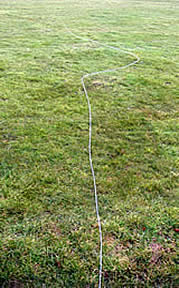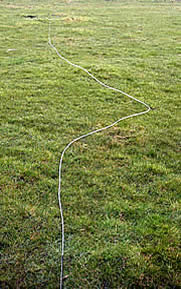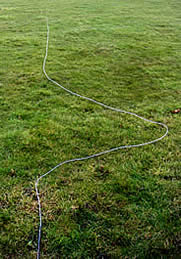 The Reach Mend Cast can be much more effective than the Reach cast when fishing across sections of a river with uneven flows, or alternatively it can be used for placing a cast around obstacles in the water on both rivers and stillwaters. The only difference between the two casts is the introduction of an extra movement after the stop at the end of the forward stroke. In this particular instance, let us concentrate on the uneven flow scenario which is the reach mends
The Reach Mend Cast can be much more effective than the Reach cast when fishing across sections of a river with uneven flows, or alternatively it can be used for placing a cast around obstacles in the water on both rivers and stillwaters. The only difference between the two casts is the introduction of an extra movement after the stop at the end of the forward stroke. In this particular instance, let us concentrate on the uneven flow scenario which is the reach mends  most common use for the river angler. Let me explain:
most common use for the river angler. Let me explain:
Imagine you are faced with an uneven current speed, e.g. intermittent fast and slow flowing sections in front of you (in this scenario the river is flowing right to left). You will need to ensure that your fly (especially a dry fly) does not get dragged away too quickly from the slower flowing section of the current, or pocket (where the fish may be) when your fly line lands on the faster flowing section. So to prevent this happening you need to throw an upstream mend into your fly line at the  exact position on the water where the current is fastest (rather like a "v" on it's side, i.e. this > or this < ) this will hold your fly in the taking zone for much longer inviting a fish to take.
exact position on the water where the current is fastest (rather like a "v" on it's side, i.e. this > or this < ) this will hold your fly in the taking zone for much longer inviting a fish to take.
It is here that the extra movement is required to introduce this mend into the cast, making this cast different from the Reach cast. So, in addition to stretching out your casting arm upstream of your intended delivery point, (as described in the reach cast section) and whilst the fly line is still airborne, you must then bring your rod tip back to the position in front of you from whence it came. These movements must be done after the rod tip has stopped in the forward cast. How long you wait after the stop before you introduce these (Zig Zag) movements will dictate where your mend will manifest itself along the length of your fly line, and therefore where it will land on the water in relation to the flow, allowing you to hold your fly (ahead of it) exactly where you want it in relation to where the fish is, or where you think the fish is, thus giving you a better chance of success.
Picture 1 shows the mend at the far end. Picture 2 shows the mend midstream and Picture 3 shows the mend nearest to the angler. which one you require depends on where the fastest part of the flow presents itself on the water.
Timing the Ariel Mend
-
Stop (Zig Zag) with no pause will send the mend to the far end.
-
Stop, Pause (Zig Zag) will send the mend mid way across the current.
-
Stop, Pause, Pause (Zig Zag) will bring the mend close to you.
|
The size of the Zig Zag movement will dictate the size of the mend you want to put into the fly line, and the amount of fly line you shoot into the cast can be used to do two things, (1) it will allow you to dictate the distance at which you throw the mend, and (2) if necessary you can also use it to assist with the size of mend you require whilst performing the Zig Zag movement.
< Back
